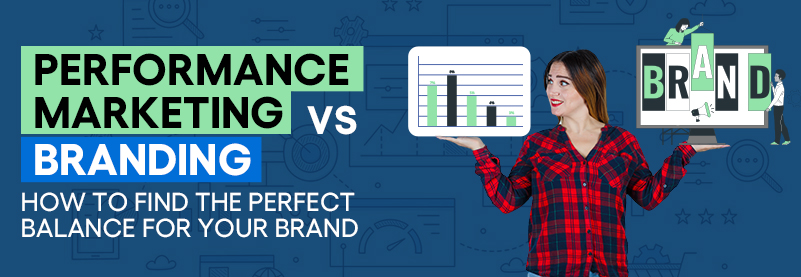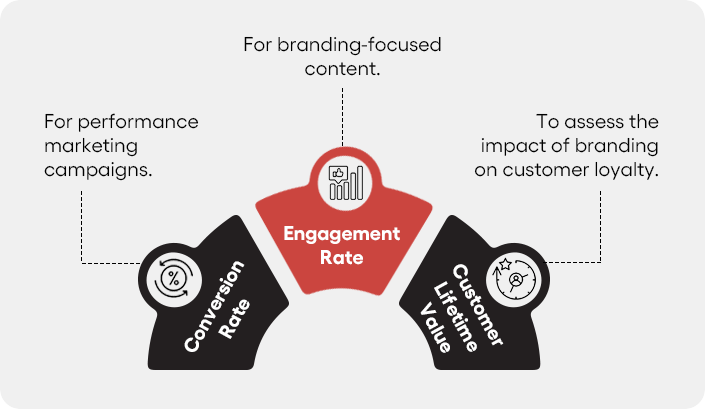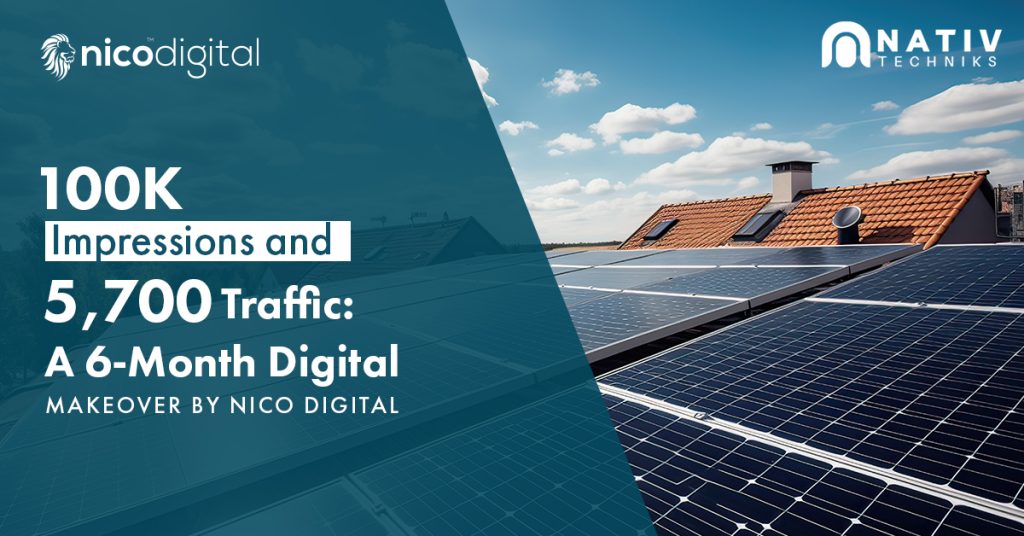
Do I drive immediate sales with my marketing budget? Or do I invest it in building a killer brand?
These are some of the common questions marketers of today ask themselves. However, few marketers actually try to find the sweet spot between both.
This is because, although both strategies serve distinct purposes, they can work together to enhance the effectiveness of a marketing strategy.
But, how do you find the perfect balance between both?
Well, if you have ever faced this dilemma of how to split your marketing budget between conversion-focused campaigns and brand building efforts, then you are at the right place.
Read on, as we explain the differences between performance marketing and branding and offer tips to help you find the right balance to grow your brand.
What is performance marketing?
Performance marketing is a strategy where brands pay for specific results. These results could be a click, lead, or sale.
Performance marketing is typically associated with online campaigns, where every action is tracked. This allows brands to see immediate results and ROI (return on investment).
$365.37B to $1,154.43B—that’s the projected growth of the global digital advertising market from 2022 to 2030.
Source: Grand View Research
Performance marketing campaigns have a short timeline, and their goal is to drive sales from customers who are already in the market, and searching for a particular product or service.
Common Types of Performance Marketing
There are some common types of performance marketing campaigns that most advertisers prefer to run. Let’s have a look
Pay-Per-Click (PPC)
Advertisers pay each time their ad is clicked. A popular example is Google Ads.
Affiliate Marketing
Companies pay partners or influencers a commission for driving sales or leads through their platforms.
Social Media Ads
Platforms like Facebook, Instagram, and LinkedIn allow brands to pay for targeted ads.

$72.3 billion
was spent on social media ads
in the U.S. in 2023.
Source: Invoca
Display Advertising
Ads are shown across various websites and can be billed by impressions or clicks.
You can read more about performance marketing and its types here.
Performance Marketing Measurement
Below are the top performance marketing metrics that help us evaluate the success of our campaigns, optimize our strategies and ensure our marketing efforts are bearing fruit.
1. Action-Oriented
This is the cost associated with acquiring a new customer for a company throughout a performance marketing campaign.
2. Conversion Rate
This is the total percentage of users who complete a specific action. This can be in the form of making a purchase or filling out a form.
3. Return on Ad Spend
This is the total revenue generated for every dollar that is spent on advertising.
4. Click-Through Rate (CTR)
CTR is the net ratio of users who click on a particular ad to the total number of users who just view the ad.
Benefits of Performance Marketing
Below are some of the benefits of performance marketing which make it an attractive and effective approach for brands aiming for measurable and rapid growth.

Now that you have a fair idea of performance marketing, let’s have a look at branding.
What is Branding?
Branding is the process by which companies aim to create a unique identity and a positive perception of themselves in the minds of consumers.
Branding is all about creating a positive image and emotional connection which makes customers feel more attached to a brand. Branding utilizes techniques like storytelling, emotional connections and consistent messaging to build brand loyalty and foster awareness in consumers.

Source: EMarketer
A good example of branding would be brands like Nike and Apple. These companies have heavily utilized branding to create an emotional connection with their audience.
One important thing to note here is that branding doesn’t drive immediate sales like performance marketing. However, it aims to build trust and recognition that can lead to long-term loyalty.
Elements of Branding
There are certain elements of branding that shape how a brand is perceived in the minds of customers.

These elements of branding are crucial in shaping the overall “look and feel” of a brand. They also help in establishing a consistent image and tone that resonates with the target audience and helps to set the brand apart from competitors.
Types of branding
Just like performance marketing, there are certain types of brand marketing strategies that companies may use to leverage their branding efforts.
. Content Marketing
Creates valuable content (blogs, videos) to build authority and foster brand loyalty.
Blog posts are the most
popular type of content.
Source: SEMrush
. Social Media Marketing
Engages audiences on platforms like Instagram and Twitter, building community and brand personality.
. Influencer Marketing
Partners with influencers to boost brand credibility and reach targeted audiences.
. Public Relations (PR)
Uses media coverage and partnerships to enhance brand credibility and visibility.
. Email Marketing
Builds customer relationships through newsletters, offering brand news and value.
Benefits of Branding
Although brand marketing doesn t drive immediate sales, there are certain benefits to it which makes it an attractive choice for marketers and brands.
. Ability to charge a premium
A powerful aspect of brand building is that established brands can charge a premium for their services. Thus, they have higher profit margins and greater revenue compared to their competitors.
$17.8 B was the brand value
of Gucci in 2023
Source: Statista
. Customer Loyalty
Branding helps create a loyal customer base, which can reduce customer churn over time.
. Emotional Connection
Strong branding builds an emotional connection that can turn customers into advocates.
. Differentiation
It sets you apart from competitors, making it easier for people to recognise and remember your brand.
Branding is a long-term investment and typically doesn’t deliver immediate measurable results. However, it can help create a foundation that can make other marketing efforts, like performance marketing, more effective.
Performance Marketing vs. Branding: Key Differences
| Aspect | Performance Marketing | Branding |
| Goal | Immediate results (sales, leads, clicks) | Long-term customer loyalty and recognition |
| Measurement | Measurable, data- driven | Harder to measure, qualitative |
| Focus | Short-term wins | Long-term growth |
| Budget | Pay for each action | Consistent investment over time |
| Impact on Customers | Direct, action-oriented | Emotional, trust- oriented |
Both approaches aim to grow a business. However, performance marketing is transactional, while branding is relational. By understanding these differences, brands can better decide when to prioritise each approach.
Why Balancing Performance Marketing and Branding Is Important
Marketing is all about finding the right mix of strategies that work best for a brand. Thus, focusing too much on just one strategy can be detrimental to a brand’s growth.
Brands that focus solely on performance marketing may achieve quick wins. However, they may struggle to retain customers. On the other hand, brands that focus only on branding may build strong customer loyalty. But they risk falling behind competitors who actively pursue conversions and sales.
According to research by Forbes, when businesses focus too much on performance marketing, they tend to neglect brand building which is crucial for long-term growth.
Thus, marketers need to balance between both.
Below are some more compelling reasons why balancing performance marketing and branding is important.
. Maximise Reach and Engagement
Performance marketing can drive reach, while branding strengthens engagement. Together, they enhance the customer experience as a whole.
Thus, when combined, performance marketing and branding complement each other perfectly. Performance marketing draws in new customers, while branding builds lasting relationships, which helps those customers feel connected and valued.
Together, they enhance the customer experience by making interactions with the brand more meaningful and memorable. And this ultimately leads to higher satisfaction and long-term loyalty.
. Boost Short-Term Sales and Long-Term Growth
A main difference between performance marketing and branding lies in the focus of their respective timeframes. Performance marketing on one hand delivers quick wins, like immediate sales or leads. On the other hand, branding focuses on long-term growth by establishing a strong brand identity.

Thus, if marketers rely on one sole approach, it can lead to missed opportunities. For example, with performance marketing, a business can see immediate sales but struggle with customer loyalty if it neglects branding.
However, if a company invests only in branding, it can develop a strong brand image. However, it may fall short of revenue which may be important to sustain operations.
. Build Brand Equity
Utilizing performance marketing with branding can help enhance brand equity, which is the perceived value of a brand in the minds of consumers.
When short-term performance metrics are aligned with long-term brand goals, companies can create a cohesive strategy that not only drives sales but also fosters lasting customer relationships.
. Future-Proof the Business
A strong brand presence supports future performance campaigns, while performance marketing helps the brand maintain relevance.
Together, these approaches help create a cycle of support. Branding lays the groundwork for effective performance marketing by building trust and familiarity. And performance marketing keeps that brand awareness active and top-of-mind, ensuring the brand remains competitive and relevant.
Tips for Balancing Performance Marketing and Branding
If you are looking for sustainable growth, then you need to balance performance marketing with branding. But how do you exactly go about it?
Well, check out these tips we have listed below and get ready to create a strategy that maximises both immediate results and long-term brand loyalty.
1. Define clear goals
This is the first step in creating a killer marketing strategy that balances both performance marketing and branding.
Try to understand what you want to achieve with both performance marketing and branding. If your goal is to drive immediate sales for a new product, you will have to allocate more resources to performance marketing. If your goal is to increase brand loyalty, you will have to invest more in branding.
Now, let’s look at what an example goal might be.

Setting specific objectives for each strategy will help you better allocate your resources and also accurately measure your success.
2. Build a strong brand foundation first
If you are at a stage where you have to choose which strategy to carry out first, then it is advisable to start with branding. This is because establishing a solid brand foundation makes performance marketing more effective. .
Customers are more likely to engage with ads from brands they recognise and trust. Thus, you should be investing in elements like a logo, brand colours, and messaging before running ads as this can yield better results.
3. Allocate your budget strategically
You can think of your budget as a spectrum, with a certain portion allocated to performance marketing and another portion to branding.
Marketing researchers Binet and Field had a particular split for allocating the budget to these two strategies, called the 60-40 split. After studying the advertising effectiveness of some of the top companies, they came to the conclusion that allocating 60% of a company’s budget to brand building and the rest 40% to performance marketing could yield the best results.
Below is an example of a sample budget allocation.

Marketers can adjust this ratio based on their goals and campaign size. In the launch phase, performance marketing may get more attention, while established brands can prioritise branding.
4. Use Content to Bridge Both Strategies
Content marketing can be an excellent tool for combining performance marketing and branding. Content can help build authority and trust, it can also be optimized to drive conversions.
Some examples of sample content ideas are given below.

Content can serve as the bridge and deliver value that resonates with the brand s identity. It can also be measurable in terms of engagement, shares and conversions.
5. Regularly Review and Adjust Based on Data
It is also important to track the effectiveness of both performance marketing and branding. Marketers can use the data from ads, website traffic and customer feedback to evaluate what s working and where adjustments are necessary.
Some important Performance Metrics to Track are given below.

By regularly reviewing these metrics, you can make data-driven decisions on how much focus to give each approach at a particular time period.
Final Thoughts: Achieving Harmony Between Performance Marketing and Branding
So, performance marketing or branding? Well, you have the answer. It s a combination of both. And finding the perfect balance between performance marketing and branding takes careful planning, strategic budget allocation, and consistent evaluation.
Both strategies complement each other and help to create a marketing approach that drives immediate results while also building a loyal customer base for the future.
Thus, by integrating performance marketing and branding in a way that aligns with your goals, you can create a brand that is both profitable and memorable, and set the foundation for long-term success.
Ready to supercharge your brand with a balanced approach to performance marketing and branding?
At Nico Digital, we specialise in creating tailored strategies that drive measurable results while building lasting connections with your audience.
Let s grow your brand SUSTAINABLY.
Connect with us today to start your journey.











